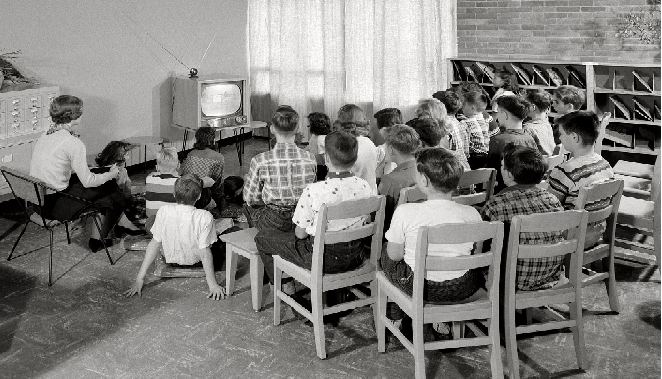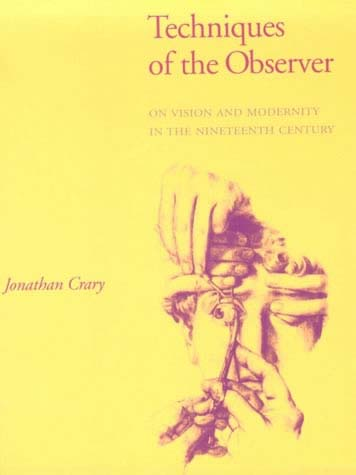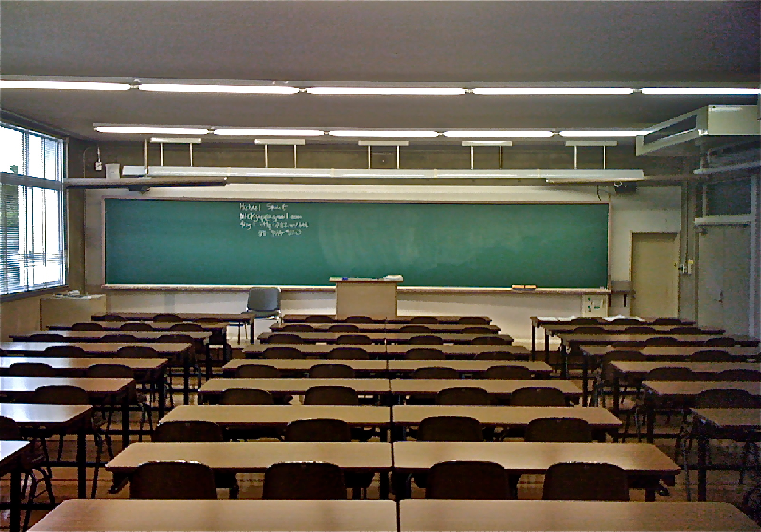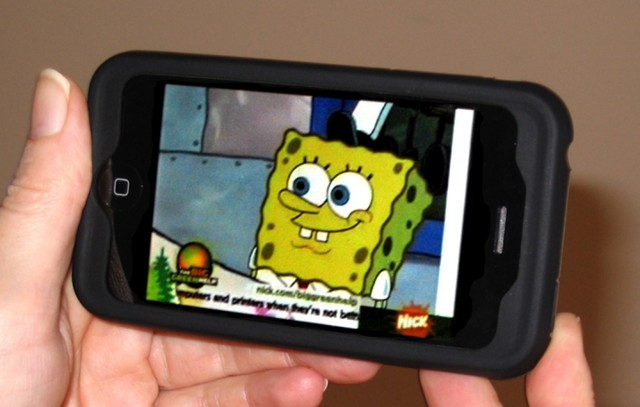Classroom/Space
Amelie Hastie / Amherst College

In the third chapter of Techniques of the Observer, Jonathan Crary opens with a discussion of Goethe’s description of a room. Initially pointing to that perception engendered by a camera obscura, Goethe instead turns, Crary writes, to describe “the corporeal subjectivity of the observer.” [1] He continues, drawing on the work of Francois-Pierre Maine de Biran, to note: “the body becomes a stubborn physical fact.” [2] Of course, the very sensations of the body of the observer remain grounded in the very room in which she or he sits. For me, this is a provocative — and extraordinarily appropriate — way to think not only about television spectatorship but also those other spaces that enable our sense of perception to take hold.

I want to begin, then, by contextualizing my own pedagogical practices through a consideration of the critical and institutional spaces that have inevitably informed me as a teacher, scholar, and colleague. My graduate training was at the University of Wisconsin-Milwaukee, where I earned my PhD in the Modern Studies program of the English Department. During the period of my study, Modern Studies was the program where both Film and Media Studies and Critical Theory were lodged. But it was just one of five programs at the time, which also included Literary Studies and Composition (as well as Creative Writing and Linguistics). Thus the context for our study and research was inevitably an interdisciplinary one (along with courses in Film, Television, and Critical Theory, for instance, I also took classes in nineteenth-century US literature, as well as interdisciplinary topical courses). I was therefore steeped in disciplinary studies — film and media, composition, literature — that together were set within an interdisciplinary model for research and teaching.
From UWM, I took a job at the University of California-Santa Cruz in the Film and Digital Media department, where I worked for almost a dozen years. Here my teaching became immersed in the discipline of Film and Media Studies, yet in the context of a program that included, equally, Production and Critical Studies. Our philosophy was that these two arms of “theory” and “practice” must be in conversation (or, at the very least, that students take courses in each). But while my teaching here was more “disciplinary” than “interdisciplinary,” my scholarship and my collegial practice were both informed by working with artists. From UCSC, I moved to Amherst College, a small liberal arts in New England, to start a program in Film and Media Studies. And here I was able to capitalize on resources to develop a major for students that thrives on an integrated practice between artistic and scholarly production in moving-image media. Moreover, being simultaneously housed also in an English department, my courses have again taken on an interdisciplinary thrust and, in some cases, a renewed attention to writing (especially at the “introductory” level). This institutional move has been, then, a return to some of my interdisciplinary roots as both a student and a teacher, but it has always carried with it the insistence on the complementary, if also “disciplined,” work of artists and scholars, which together create an inherently interdisciplinary practice.

These three institutional sites, and my own place within them, have inevitably shaped my primary pedagogical site as well — that is, the “space” of the classroom. The classroom, after all, is that space where we continuously practice our own changing ideas, which are themselves in turn transformed by the students in the room with us. In my case, I encourage a creative critical practice as viewers, researchers, and writers in my classroom. And in both film and television courses, I try to integrate the following concerns: the materiality of viewing experiences, medium specificity, changing modes of viewing practices, and an expansion of what counts as “theoretical” material. These elements culminate in some of the writing assignments I offer students (and which I also attempt to complete myself, whenever possible). And they also, inevitably, recognize the body who watches and writes as a “stubborn physical fact.”
In the past few years, in what might seem a strange revenge scenario against all those non-specialists who integrate film and television into their syllabi (sometimes as a “break” from more serious study, sometimes as a “fun” addition, sometimes as a form of representation of a particular idea – but rarely as a medium- and culturally-specific form), I have increasingly added works outside of the discipline of Film and Media Studies into my own syllabi: poetry, novels, memoirs, personal essays, etc. And I’ve also been teaching a first-year seminar called “Things Matter” — an introduction to studies of Material Culture without the theoretical readings of the field — which includes a unit on various media forms. The latter class has, in many ways, shaped my approach to my upper-division courses in Film and Television Studies. Throughout “Things Matter,” I assign a series of “Object Lessons,” in which I implore students to “write in the form that the thing demands.” Ultimately my goal is not to have them produce, say, essays in the shape of a pair of socks or a candy bar, but rather to consider what shape their writing might take in response to particular objects. How, for instance, would they approach a discussion of a television series in relation to the device on which they watch it? How does the one inform the other, and how does that relationship inform their own writing?
My foundations course in Television Studies, “Knowing Television,” centrally inquires, as the name implies, how we know television — as a medium, a textual system, a cultural object. And how, I continually ask (if only to inform my assignments), do we write in the form that this particular “thing” demands? First and foremost, I think, we must recognize television as always an intertextual system and, as one that incorporates many kinds of material devices. In this way, writing about television always demands an ability to move between, whether that’s between texts, between devices and images, or between the spectatorial experience of perception and that thing or image that we perceive. Let me here offer a response of my own design to return to that image with which I began via Crary and Goethe: the room where we sit and how it might open and close depending on our visual focus.

Time-shifting has undeniably eliminated certain elements of television viewing. But space-shifting — transferring the interface to an extension of our bodies or something very near to it — has altered other aspects as well. At least in terms of our physical proximity to it, the hand-held screenic device makes television viewing more like reading. But of course the television set was not originally designed as a replacement for the novel. Rather than isolate readers in space from one another, as novels do, and, in a sense, from the very rooms where they sit, the television sought to unify members of a room (as members of a family) in a shared space. This architecture of space enabled particular kinds of viewing practices, coterminous with the structure of content of commercial broadcast television in particular. So, while television’s form invited a distracted viewer, one whose distraction was born of the “interruptions” that make up commercial broadcast television, its spatial structure similarly allowed for a sense of distraction. That spatial distance meant one could look across the room at another viewer, shift one’s line of vision to another part of the larger space of which the viewing room was a part, or simply take in a broader point of view around the set itself. In this form, the viewer watches the set and the texts it screened in the context of the space in which it was/is situated. What happens, then, when the viewing device produces a more immediate proximity to what we see, particularly as our interfaces are, in essence, these very same objects we hold in our hands? How do our bodies adapt to what we see through how we see it? And what role does spatial proximity or distance, as enabled by those things we control, play in relation to our narrative, perceptual and affective experiences?
Simply put, television study — and the writing about it that I encourage my students to practice — must be contextualized in time and space, particularly as “time” and “space” continuously shift. Knowing television demands a consciousness of the experience of perception and of the physical body who both perceives and exists in material space oneself. Entering into these coterminous spaces invokes a learning and writing practice that, I hope, allows the “I” of the student to maintain a critical, creative, and embodied response to what might otherwise seem to be ephemeral images moving on the screens before us.
Image Credits:
1. TV Classroom.
2. Techniques of the Observer.
3. Classroom space.
4. TV on our phone.
Please feel free to comment.
Really wants to spend time in good colleges with good classes. Maybe this can be improved by reading the article on this site https://www.home-dzine.co.za/decor/decor-more-space-in-dorm-room.html because the topic is very interesting and relevant especially for underdeveloped schools or colleges. So read “Decor more space in a dorm room”.